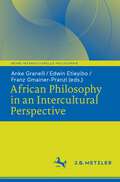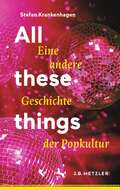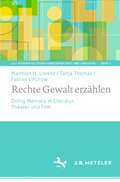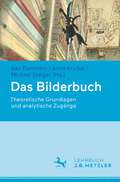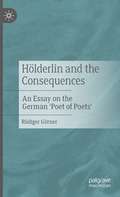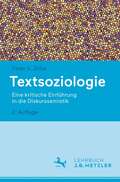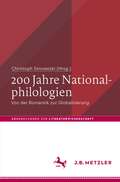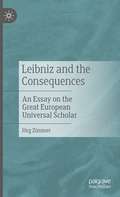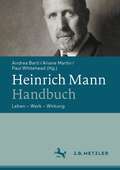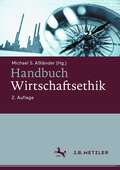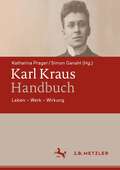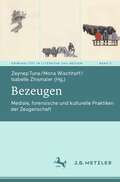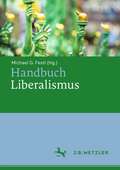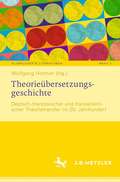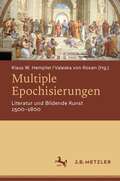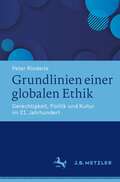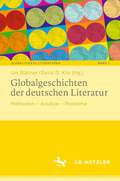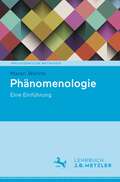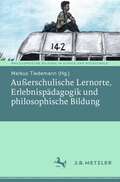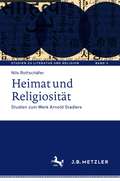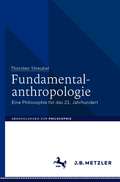- Table View
- List View
African Philosophy in an Intercultural Perspective (Reihe Interkulturelle Philosophie)
by Anke Graneß Edwin Etieyibo Franz Gmainer-PranzlAfrican philosophy under the specific conditions of a colonial and postcolonial world is – at least since the 20th century if not even earlier – inherently intercultural. The aim and target of the volume is to reveal, interrogate and analyse the intercultural dimension in African philosophy, and to critically interrogate the project of an intercultural philosophy from an African perspective. This volume is the first publication that explicitly discusses African philosophy as a challenge to the project of intercultural philosophy.
All these things: Eine andere Geschichte der Popkultur
by Stefan KrankenhagenPopkultur dreht sich immer schon um die ganz besonderen und die ganz normalen Dinge: von Winnetous Silberbüchse über Kaugummis, Diskokugeln und Nylonstrümpfen bis zu Selfiesticks und Michael Jacksons weißem Handschuh. Sie werden alltäglich genutzt und abgöttisch verehrt, sind überall verfügbar und unerreichbar, sind spektakuläre Unikate und billige Massenprodukte. – All these things erzählt die Geschichte der Popkultur vom Ende des 19. Jahrhunderts bis zur Gegenwart anhand von 14 ausgewählten Dingen. Sie alle haben ihre eigene Geschichte und stehen für die kulturellen, technischen und ökonomischen Veränderungen der Zeit – vor allem aber für 150 Jahre Unterhaltungskultur.
Rechte Gewalt erzählen: Doing Memory in Literatur, Theater und Film (LiLi: Studien zu Literaturwissenschaft und Linguistik #1)
by Matthias N. Lorenz Fabian Virchow Tanja ThomasRechte Gewalt, die in der Bundesrepublik Anfang der 1990er Jahre Konjunktur hatte und in den letzten Jahren abermals stark angestiegen ist, ist bis heute nur äußerst lückenhaft aufgearbeitet und wird künstlerisch kaum erinnert. Wenn überhaupt, herrschen Täterperspektiven im Rahmen eines rein ‚weißen‘ Erinnerungsrahmens vor, die Stimmen der Opfer bleiben ungehört. Ausgehend von der Beobachtung, dass mit der gesellschaftlichen Missachtung dieser Gewalt eine zweite Traumatisierung stattfindet, fragt der Band nach Formen, Leistungen und Defiziten der dokumentarischen wie fiktionalen Aufarbeitung rechter Gewalt in Literatur, Theater und Film. Die erzählenden Künste werden in den untersuchten Beispielen sowohl auf ihren Beitrag zu dem beobachteten Missstand als auch hinsichtlich ihres Potentials zu dessen Überwindung untersucht.Mit Beiträgen von Svea Bräunert, Anna Brod, Gabriele Fischer, Hans-Joachim Hahn, Matthias N. Lorenz, Jonas Meurer, Dan Thy Nguyen, Corinna Schlicht, Sebastian Schweer, Tanja Thomas, Fabian Virchow, Johanna Vollmeyer und Stefan Winterstein.
Handlungsorientierung im Fremdsprachenunterricht: Eine Einführung
by Dagmar Abendroth-Timmer David GerlachDieser Band entwickelt das Konzept der Handlungsorientierung in fremdsprachendidaktischer wie bildungstheoretischer Hinsicht weiter: Lernende als autonom agierende Individuen mit je unterschiedlichen (Sprachlern-)Biographien werden mit ihrer kulturellen Identität und ihrem sprachlichen Handeln in den Mittelpunkt gerückt. Gleichzeitig wird das Fremdsprachenlernen methodisch differenziert und als kontextgebunden verstanden. Lehrpersonen erschaffen für und mit den Lernenden inhaltlich bedeutsame Lernsituationen. – Eine fremdsprachenübergreifende Einführung mit Definitionen, Vertiefungen und zahlreichen Praxisbeispielen für alle Phasen der Fremdsprachenlehrer*innenbildung.
Das Bilderbuch: Theoretische Grundlagen und analytische Zugänge
by Ben Dammers Anne Krichel Michael StaigerDas Bilderbuch ist ein vielschichtiges multimodales Erzählmedium, das in den vergangenen Jahrzehnten einen tiefgreifenden ästhetischen Wandel durchlaufen hat. Dieser Band bietet eine umfassende Grundlage für die Arbeit in Lehrveranstaltungen: Im ersten Teil wird in die Theorie und Geschichte des Bilderbuchs eingeführt und ein sechsdimensionales Analysemodell vorgestellt. Der zweite Teil enthält fünfzehn Modellanalysen mit jeweils unterschiedlichen Fokussierungen, z.B. zu Aspekten der bildlichen und sprachlichen Gestaltung im Bilderbuch oder zu ausgewählten Gattungen und Themen. – Mit Leitfragen zur Analyse und vielen farbigen Abbildungen.
Hölderlin and the Consequences: An Essay on the German 'Poet of Poets'
by Rüdiger Görner"A sign we are, uninterpreted. Painless we are and have almost / lost the language in a foreign country." Thus begins the second version of Friedrich Hölderlin's hymn dedicated to goddess of memory, Mnemosyne. "Hölderlin and the Consequences" wants to remember this 'poet of poets' and consider what his unmatched poems have stimulated, even triggered, in others. This scholarly essay examines the legacy of a poet who was, by and large, ostracized in his time, a master of language, who was declared a stranger by his contemporaries until he became a stranger to himself. Hölderlin's multiple experience of foreignness and alienation was later counteracted by often ideologically motivated attempts to appropriate him. Rüdiger Görner presents this complex context as a special case in recent literary history.This book is a translation of an original German 1st edition, "Hölderlin und die Folgen" by Rüdiger Görner, published by J.B. Metzler, imprint of Springer-Verlag GmbH Germany, part of Springer Nature in 2016. The translation was done with the help of artificial intelligence (machine translation by the service DeepL.com). The author (with the support of Josh Torabi) has subsequently revised the text further in an endeavour to refine the work stylistically.
Textsoziologie: Eine kritische Einführung in die Diskurssemiotik
by Peter V. ZimaIm Anschluss an Adorno, Bachtin und Greimas’ Strukturale Semiotik analysiert Zima die Einwirkung sozialer Entwicklungen und Konfliktlinien auf literarische (und theoretische) Diskurse. Dabei geht es ebenso um Gattungsentwicklungen wie um semantische und syntaktische Strukturen einzelner Texte. Stets wird versucht, Gesellschaft und Literatur über die Sprache miteinander zu vermitteln. Der Band bietet vertiefte Analysen zu Proust, Musil und Kafka. Die Neuauflage enthält neue Kapitel zu den Begriffen der soziolinguistischen Situation, des Soziolekts sowie der Intertextualität und dehnt die Textsoziologie auf die Institutionalisierung literarischer Sprachen aus.
200 Jahre Nationalphilologien: Von der Romantik zur Globalisierung (Abhandlungen zur Literaturwissenschaft)
by Christoph StrosetzkiDie 17 Beiträge dieses Bandes verfolgen eine Standortbestimmung der Philologien, die – ausgehend vom Volksgeist des 19. und der Kulturkunde des 20. Jahrhunderts – sich im 21. Jahrhundert neu positionieren müssen. Die einzelnen Beiträge gehen auf Fragen ein wie: Welche Veränderungen treten mit zunehmender Globalisierung ein? Gehen die Nationalliteraturen immer mehr in der sog „Weltliteratur“ auf? Die Autorinnen und Autoren stammen aus der Romanistik, Germanistik und Anglistik. Sie behandeln Themen der Literaturgeschichtsschreibung, der Kanonisierung, der Komparatistik und auch Zukunftsfragen.
Leibniz and the Consequences: An Essay on the Great European Universal Scholar
by Jörg ZimmerLeibniz was probably the last universal scholar in modern times who made original and innovative achievements in all the essential fields of knowledge of his time: as a reform-oriented lawyer, a multilateral thinking diplomat, as a mathematician of infinitesimal calculus, as the inventor of a calculating machine and in the mining of horizontal wind power, as an organizer of science and as one of the first historians who strived for source-critical methodical objectivity. However, this baroque diversity can only be understood from the center of a monadological philosophy, which wants to establish the unity of scientific worldview and metaphysical concept of the world. It is distorted in the classical reception because only Leibniz the Theodicy was known. The topicality of Leibniz today consists in re-exposing the original basic idea of unity in diversity and asking how it can be made fruitful for philosophical and political thought in the 21st century. This book is a translation of the original German 1st edition Leibniz und die Folgen by Jörg Zimmer, published by J.B. Metzler, imprint of Springer-Verlag GmbH, part of Springer Nature in 2018. The translation was done with the help of artificial intelligence (machine translation by the service DeepL.com). A subsequent human revision was done primarily in terms of content, so that the book will read stylistically differently from a conventional translation. Springer Nature works continuously to further the development of tools for the production of books and on the related technologies to support the authors.
Heinrich Mann-Handbuch: Leben – Werk – Wirkung
by Andrea Bartl Ariane Martin Paul WhiteheadHeinrich Mann (1871-1950) gehört zu den prägenden Autoren des 20. Jahrhunderts. Sein Werk umspannt ästhetisch die Epochen vom Fin de Siècle über den Expressionismus bis zur Klassischen Moderne, politisch Kaiserreich, Weimarer Republik und antifaschistisches Exil. Gerade in den 1920er und 1930er Jahren ist er ein vielbeachteter Essayist und Publizist, der – als überzeugter Europäer und ‚Republikaner‘ – die gesellschaftlichen Entwicklungen seiner Zeit kritisch begleitet. Auch literarisch zeichnet er mit „Der Untertan“ ein Psychogramm des deutschen Spießers oder mit „Professor Unrat“ ein satirisches Sozialporträt falscher Doppelmoral. Daneben steht noch ein anderer Heinrich Mann: der Ästhet und experimentierfreudige Dichter, der Zeichner, der Liebhaber moderner Medien. Das Handbuch mit seinen rund 90 Beiträgen nimmt Manns facettenreiches, faszinierendes Gesamtwerk in den Blick, summiert die Forschung und bietet neue Perspektiven auf einen großen Autor.
Handbuch Wirtschaftsethik
by Michael S. AßländerKlimawandel, Ressourcenknappheit und Umweltschutz, Armutsmigration, Ungleichheit, prekäre Beschäftigungsverhältnisse und Menschenrechte, aber auch Big Data und die digitalisierungsbedingte Veränderung der Arbeitswelt sind die alten und neuen Herausforderungen, denen sich die Wirtschafts- und Unternehmensethik stellen muss. Das Handbuch bietet einen umfassenden Überblick über die wirtschaftsethischen Standards von der Antike bis in unsere unmittelbare Gegenwart und soll Orientierung durch Reflexion, Methoden und kritische Analyse bieten. Für die 2. Auflage wurde das Handbuch umfassend aktualisiert und erheblich erweitert.
Karl Kraus-Handbuch: Leben – Werk – Wirkung
by Isabel Langkabel Johannes KnüchelDer Wiener Publizist Karl Kraus (1874–1936) war eine zentrale Figur der europäischen Moderne. Sein monumentales Werk umfasst nicht nur Essays, Aphorismen, Gedichte und Dramen, erschienen großteils auf den tausenden Seiten seiner Zeitschrift Die Fackel, sondern auch hunderte Vorlesungen, Radiosendungen, Plakatkampagnen und Rechtsfälle. Er prägte seine Zeit ebenso, wie sie ihn prägte, etwa in dem Antikriegsdrama Die letzten Tage der Menschheit und der Dritten Walpurgisnacht, seiner frühen Analyse des Nationalsozialismus. Die Kraus’sche Medienkritik, sein präzises Sprachdenken und aufklärerischer Witz haben das kritische Denken weltweit beeinflusst und zeigen bis heute, was es heißt, ein öffentlicher Akteur zu sein.
Bezeugen: Mediale, forensische und kulturelle Praktiken der Zeugenschaft (Kriminalität in Literatur und Medien #2)
by Verena Arndt Simone SchmitzDer Band widmet sich Praktiken der Zeugenschaft in gerichtlichen und außergerichtlichen Kontexten. Untersucht werden Episteme, Materialitäten und Medialitäten, die Zeugenschaft und Zeugenwissen generieren und bedingen. Es stellt sich die Frage danach, wie diese hergestellt und beglaubigt, aber auch selegiert und manipuliert werden. Neben menschlichen Zeugnisgebenden gerät ebenso die Zeugenschaft von Bildern und anderen Formen der Repräsentation ins Blickfeld. Die Beiträge nehmen mithin so vielfältige Phänomene in den Blick wie den Auftritt im Gerichtssaal, sogenannte Theatertribunale, das Ad-hoc-Bezeugen mittels digitaler Technologien sowie Archivierungen von Zeitzeugenschaft. Der Sammelband gliedert sich in die vier Sektionen (I) Kollektives Bezeugen und digitale Medien, (II) Aufführen und Bezeugen, (III) Bezeugende Bilder, (IV) Erinnern und Bezeugen.
Handbuch Liberalismus
by Michael G. FestlKeine Denkungsart kann es in Sachen Wandlungsfähigkeit mit dem Liberalismus aufnehmen. Ohne diese Eigenschaft hätte der Liberalismus kaum über Jahrhunderte hinweg einflussreich bleiben können. Zugleich ergeben sich aus dieser Wandelbarkeit zwei wichtige Implikationen für ein tieferes Verständnis des Liberalismus. Erstens erschwert sie die Herausarbeitung dessen, was am Liberalismus eigentlich zentral ist. Welche Prinzipien und Werte sind partout nicht verhandelbar? Zweitens legt seine Wandelbarkeit nahe, ihn in Krisenzeiten – wie heute und nicht zum ersten Mal –nicht voreilig abzuschreiben. Welche Art des Wandels aber müsste der Liberalismus durchlaufen, um die gesellschaftlichen Probleme unserer Zeit zu meistern? Diese beiden Fragen fungieren als Ankerpunkte des Handbuches: Einerseits will es zum Kern des Liberalismus vordringen, indem es Prinzipien und Werte des Liberalismus auslotet, und andererseits dessen Stellung bezüglich aktueller Herausforderungen beleuchten. Auf dem Weg dorthin werden klassische Vertreterinnen und Vertreter sowie wichtige historische Ereignisse vorgestellt, in denen der Liberalismus eine wichtige Rolle gespielt hat, Konkurrenten und Varianten des Liberalismus besprochen sowie „über den Westen hinaus“ geschaut.
Theorieübersetzungsgeschichte: Deutsch-französischer und transatlantischer Theorietransfer im 20. Jahrhundert (Globalisierte Literaturen. Theorie und Geschichte transnationaler Buchkultur / Globalized Literatures. Theory and History of Transnational Book Culture #2)
by Wolfgang HottnerIm Zuge der Historisierung von Theorie ist die Rolle von Übersetzungen sowie die vermittelnde Rolle der Übersetzer*innen bisher nur am Rande berücksichtigt worden. Doch für die Rezeption, Internationalisierung und Kanonisierung von Theorie spielen diese eine entscheidende Rolle, weshalb sich dieser Band der Geschichte der Theorie in Hinblick auf ihre Übersetzungen nähert. Die Brisanz, die Theorie in Deutschland, Frankreich und den USA von Anfang der 1960er bis Ende der 1990er Jahre entfalten konnte, verdankt sich nicht nur der Mobilität ihrer Protagonist*innen, sondern auch der Verfügbarkeit von Übersetzungen, in denen Theorie von einer Sprache in die andere übergeht, dabei ‚anschlussfähig‘ wird. Theorieübersetzungsgeschichte rückt die Arbeit von Übersetzer*innen in den Blick, die wechselseitige Beziehung von Übersetzungstheorie und poststrukturalistisch-dekonstruktivem Denken sowie ein spezifisches Verständnis von Übersetzung, das mit dem Anspruch verbunden ist, im Verlauf gegenwärtiger Debatten zu intervenieren.
Multiple Epochisierungen: Literatur und Bildende Kunst 1500–1800
by Klaus W. Hempfer Valeska Von RosenEntgegen einer pauschalen Kritik an den Epochenbegriffen diskutieren die Beiträge des vorliegenden Bandes historische und systematische Bedingungen der Möglichkeit von Epochisierungen. Unterschiedliche sozio-kulturelle Systeme werfen unterschiedliche Fragen auf. Als Literatur- und Kunstwissenschaftler/innen gehen die Beiträgerinnen und Beiträger von Problemkomplexen ihrer jeweiligen Disziplinen aus, rekurrieren für Lösungsansätze aber auch auf das Theorieangebot anderer historischer Disziplinen wie der Geschichtswissenschaft im Allgemeinen oder der Wissenschaftsgeschichte im Besonderen. - Insgesamt ergibt sich, dass die berechtigte Kritik an der spezifischen Faktur spezifischer Epochisierungen weder aus systematischen noch historischen Gründen den generellen Verzicht auf Epochisierungen nahelegt. Solange kein konsistentes Gegenmodell vorliegt, kann es nur darum gehen, Epochentheorie allgemein und Theorien der jeweiligen Einzelepochen im Zusammenhang zu optimieren.
Verbrechen als „Bild der Zeit“: Kriminalitätsdiskurse der Weimarer Republik in Literatur, Film und Publizistik (Kriminalität in Literatur und Medien #1)
by Christof Hamann Susanne DüwellWährend der Zeit der Weimarer Republik entsteht ein breites Spektrum an Verbrechensdarstellungen und Reflexionen über Kriminalität, das erst zum Teil bzw. in Einzelstudien erforscht ist. Zudem stehen vor allem ausgewählte kanonische kriminalliterarische Texte und Filme im Zentrum des Interesses. Ziel des geplanten Bandes ist es, gerade die Vielfalt und Bandbreite an Darstellungsformen und diskursiven Verhandlungen von Kriminalität zwischen 1918 und 1933 zu diskutieren und dabei literatur-, medien-, diskurs- und wissensgeschichtliche Perspektiven miteinander zu verbinden.
Grundlinien einer globalen Ethik: Gerechtigkeit, Politik und Kultur im 21. Jahrhundert
by Peter RinderleDie Globalisierung stellt die Ethik vor ganz neue Herausforderungen: Einerseits sind alle Menschen in bestimmten Hinsichten gleich und zunehmend voneinander abhängig; andererseits fühlen sie sich aber verschiedenen politischen und kulturellen Gemeinschaften zugehörig. Aber wie sollen wir dann auf gerechte Art und Weise das Zusammenleben der Menschen auf unserem Planeten gestalten? Die Idee eines kosmopolitischen Suffizientarismus kann darauf eine Antwort geben, die kein Mensch mit guten Gründen zurückweisen kann: Alle Menschen – welcher Gemeinschaft oder Generation sie auch immer angehören – sollen mindestens genug für ihr Leben haben. Die globale und intergenerationelle Gerechtigkeit macht also nicht an den Grenzen von Gemeinschaften halt, denn alle Menschen teilen bestimmte Grundbedürfnisse. Sie verlangt aber keine vollständige Gleichstellung aller Menschen, denn damit würde man sowohl die politische Selbstbestimmung von Gemeinschaften als auch die globale Diversität von Kulturen in Frage stellen.
Globalgeschichten der deutschen Literatur: Methoden – Ansätze – Probleme (Globalisierte Literaturen. Theorie und Geschichte transnationaler Buchkultur / Globalized Literatures. Theory and History of Transnational Book Culture #1)
by Urs Büttner David D. KimDeutsche Literatur wird nicht ausschließlich in deutscher Sprache geschrieben und gelesen. Literatur macht nicht an Grenzen Halt, und das Deutsche ist in sich von zahlreichen regionalen Binnenunterscheidungen durchzogen. Die Darstellung solcher Vielfältigkeit überfordert konzeptionell eine nationale Literaturgeschichtsschreibung. Dieser Band erörtert daher im Anschluss an neuere historiographische Ansätze Möglichkeiten literaturwissenschaftlicher Globalgeschichtsschreibung. Er eröffnet eine Methodendiskussion darüber, wie sich philologische Analysen, mediale Fragen und soziologische Perspektiven auf Buchmarkt, Literaturbetrieb und Literaturwissenschaft verbinden lassen. An Beispielen rund um den Globus prüfen die Artikel die Prämissen gängiger Literaturgeschichte und erproben Alternativen. Zugang zu Globalisierungsprozessen ›deutscher Literatur‹ sucht der Band im Ausgang von unterschiedlichen Fächern: neben Beiträgen der internationalen Germanistiken sind auch Komparatistik, Fremdsprachenphilologien, Buchwissenschaft, Postkoloniale Studien und Digital Humanities vertreten.
Phänomenologie: Eine Einführung (Philosophische Methoden)
by Maren WehrleIn diesem Lehrbuch wird die phänomenologische Methode nicht nur theoretisch, sondern auch in ihren aktuellen intra- und interdisziplinären Anwendungen vorgestellt und diskutiert. Zurück zu den Sachen selbst, wie sie in der Erfahrung gegeben sind – dies ist das Motto der Phänomenologie im Ausgang von Edmund Husserl. Hierzu müssen wir Selbstverständliches hinterfragen und sämtliche Vorannahmen einklammern. Wie lässt sich ein solcher Einstellungswechsel erreichen, wie gelangt man zu einer vorurteilslosen Beschreibung, wie kann das Allgemeine im Konkreten bestimmt werden und wie lässt sich nach den Bedingungen der Erfahrung zurückfragen? Dies wird mit phänomenologischen Texten erläutert sowie anhand aktueller Beispiele illustriert und praktisch eingeübt.
Sex und Moral – passt das zusammen? (#philosophieorientiert)
by Hilkje Charlotte HänelSex. Die meisten von uns haben ihn. Mal schlecht, mal gut, manchmal phänomenal. Die wenigsten denken lange drüber nach. Oder reden offen drüber. Dabei ist gar nicht so klar, was Sex eigentlich gut macht. Befriedigung? Spaß? Gemeinsamkeit? Interesse an emotionaler Bindung und Stabilität? Reproduktion? Und wann ist Sex schlecht? Oder nicht nur schlecht, sondern sogar moralisch problematisch? Hilkje Hänel zeigt, dass es gar nicht so einfach ist, zwischen problematischem Sex (weil z.B. erzwungen oder ohne Zustimmung) und gutem Sex klar zu unterscheiden. Denn viele sexuelle Handlungen, die wir vornehmen, sind zwar nicht gut, aber auch nicht moralisch problematisch. Manchmal sind wir vielleicht nicht ganz bei der Sache oder würden eigentlich gerade lieber etwas anderes machen. Manchmal müssen wir uns gegenseitig oder sogar uns selbst noch besser kennenlernen. Hänel zufolge gibt es eine große Grauzone zwischen gutem, schlechtem und moralisch problematischem Sex, wobei es häufig vor allem auf den Kontext und unsere Kommunikation ankommt. Auf der Basis aktueller Wissenschaft und medialer Bewegungen wie #MeToo verteidigt Hänel ihre Ansichten gegen die wichtigsten Einwände und argumentiert für mehr Respekt im Bett. „Hilkje Hänel ist eine echte Aufklärungsphilosophin. Sachlich, scharfsinnig und mit einem klaren Sinn dafür, dass die richtigen Worte zu größerer Freiheit führen können.“ (Eva von Redecker, Schriftstellerin und Marie-Skłodoska-Curie Wissenschaftlerin mit einem Projekt zu Authoritarian Personality an der Universität Verona, Italien) "Hilkje Hänel behandelt ein überfälliges Thema und führt die Leser in diesem Band eingängig und mit argumentativem Scharfsinn durch das Terrain zwischen Sex und Moral. Die Lektüre ist ein Vergnügen und regt an, über ein Gebiet nachzudenken, das uns alle betrifft.“ (Monika Betzler, Professorin für Praktische Philosophie und Ethik an der Ludwig-Maximilians-Universität München)
Der verborgene Sinn: Verhüllung und Enthüllung in der Musik
by Laurenz LüttekenEin Sinn, der verborgen oder enthüllt werden kann, ist eine der zentralen Denkfiguren der Neuzeit. Das betrifft auch die Frage, was Musik eigentlich sei. Je stärker man darüber nachgedacht hat, desto brüchiger, changierender ist die Annahme von einem substantiellen Wesenskern der Musik geworden. In diesem Buch geht es nicht um ästhetische oder theoretische Überlegungen dazu, sondern um die Frage, ob und auf welche Weise komponierte Musik sich selbst zum Gegenstand macht und so möglicherweise etwas von ihrem Kern preisgibt. Die optischen Metaphern von Verhüllung und Enthüllung erweisen sich dabei als ebenso hilfreich wie anschaulich. In einer Reihe von Beispielen, die vom 17. bis in die Gegenwart reichen, wird das Phänomen in seiner ganzen Vielfalt beschrieben. Dabei geht es nicht nur um Opern von Mozart bis Strauss, sondern auch um Monteverdis Vokalmusik, Haydns „Schöpfung“, die Sinfonien Bruckners oder Ligetis Etüden.
Außerschulische Lernorte, Erlebnispädagogik und philosophische Bildung (Philosophische Bildung in Schule und Hochschule)
by Markus TiedemannDie Fachdidaktik der Philosophie und Ethik fordert Problemorientierung und Lebensweltbezug. Exkursionen, außerschulische Lernorte oder ‚Outdoor Education‘ haben allerdings bisher kaum Berücksichtigung in der fachdidaktischen Forschung erfahren. Eine systematische Auslotung von möglichen Kooperationen, Synergieeffekten oder Unvereinbarkeiten wurde bisher nicht geleistet. Der vorliegende Band versucht diese Lücke zu schließen und eine erste Grundlage für weiterführende Forschungen, Erprobungen und Diskussionen zu schaffen. Er soll damit sowohl einen Beitrag zur Lehrerausbildung an Universitäten und Studienseminaren als auch für die fachdidaktische Explorationsforschung leisten.
Heimat und Religiosität: Studien zum Werk Arnold Stadlers (Studien zu Literatur und Religion / Studies on Literature and Religion #3)
by Nils RottschäferDas Werk Arnold Stadlers, das sich aus der lebendigen Sprache, aus dem Konkreten und Ambivalenten der heimatlichen Lebenswelt speist, hat Teil an dem Diskurs über Zugehörigkeit, über Angekommen- und Angenommen-Sein in einer globalisierten Welt. ‚Heimat‘ und ‚Religiosität‘ bilden die strukturbildenden Komplexe seines hochreflektierten Werks, die hier in ihrer Bezogenheit aufeinander gedeutet werden. Die Engführung beider Phänomene, nach der sich die literarischen Figuren Stadlers sehnen, fungiert als grundlegendes poetisches Prinzip der Texte. Auch die Religion kann zu einer erfahrbaren sozialen Heimat werden, die Heimat kann ebenso religiöse Züge annehmen.
Fundamentalanthropologie: Eine Philosophie für das 21. Jahrhundert (Abhandlungen zur Philosophie)
by Thorsten StreubelDie Frage nach dem Menschen ist heute – im Zeitalter der zunehmenden Verschmelzung von Mensch und Technik (Cyborgisierung), der Genom-Editierung und der fortgeschrittenen Naturalisierung des Menschenbildes – aktueller denn je. Der Autor präsentiert hier erstmals eine systematische und prägnante Darstellung der Idee einer neuen Anthropologie, welche die mundanen, transzendentalen und transphänomenalen Aspekte des Menschseins gleichermaßen berücksichtigt und die Reduktion des Menschen auf seinen biologischen Körper zurückweist. Diese ‚Fundamentalanthropologie‘ genannte Disziplin versteht sich als philosophische Grundlagendisziplin und als Herzstück der Philosophie als allgemeiner Anthropologie. Außerdem werden in diesem Band zentrale und aktuelle philosophische Themen wie Selbstbewusstsein, Identität des Ich, das Wesen des menschlichen Geistes sowie die Zukunft des Menschen erstmals zum Gegenstand fundamentalanthropologischer Analysen gemacht.
